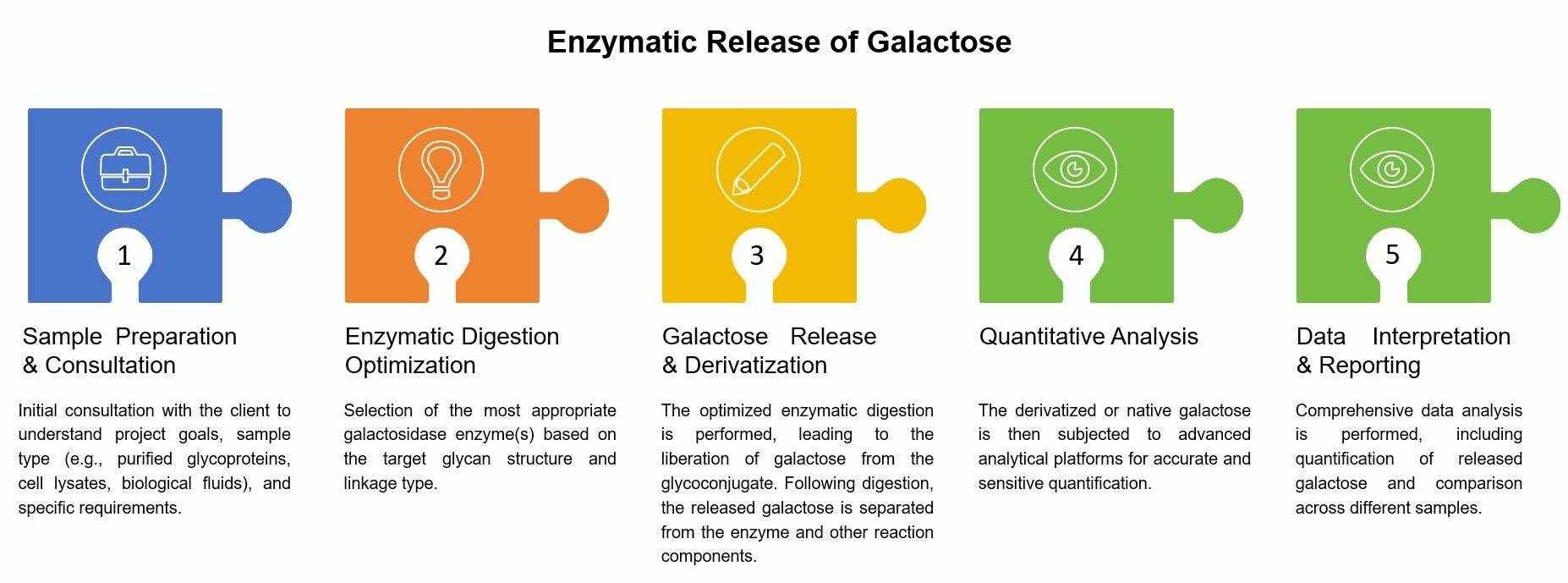



Glycans play an important role in glycoprotein folding, signaling, and other processes. To better analyze glycans on glycoproteins, we have developed an Enzymatic Release service of glycans. We provide efficient and accurate release services of β1-3 and β1-4 linked galactose from N-glycans and O-glycans.
Galactose is an important energy source and a key structural element of complex molecules that is particularly important for early human development. Galactose is involved in human metabolism and has an established role in energy transfer and galactosylation of complex molecules. Galactose exists in two main forms in aqueous solution: α-pyranose and β-pyranose, which differ in the configuration of the hydroxyl group on the ring carbon-1. The hydrolysis of lactose to glucose and galactose is catalyzed by the enzyme lactase and β-galactosidase.
The human body could not directly convert galactose into energy, but instead use sugar. Leloir is the main pathway of galactose metabolism. First, β-D-galactose is converted to α-D-galactose by galactose mutarotase (GALM). Then, galactose kinase (GALK) catalyzes the phosphorylation of α-D-galactose to galactose-1-phosphate. Next, galactose 1-phosphate is converted to uridine diphosphate (UDP)-galactose by the action of galactose-1-phosphate uridinetransferase (GALT). Finally, UDP-galactose-4'-epimerase (GALE) recycles UDP-galactose to UDP-glucose.
Since galactose plays an important role in organisms, it is necessary to develop suitable methods to release galactose from proteins for better analysis and characterization.
The precision of galactose release hinges on the judicious application of highly specific enzymatic tools. CD BioGlyco employs a suite of advanced enzymatic technologies, primarily focusing on galactosidases, which are enzymes capable of hydrolyzing terminal galactose residues from various glycoconjugates. Key enzymes utilized include:
Enzymes are used for the structural analysis of glycans and polysaccharides and for establishing structure-activity relationships in biological systems. At CD BioGlyco, we have developed specialized Glycan Release platforms to provide clients with efficient and accurate glycan release services through chemical and enzymatic methods.
β-Galactosidase is an exoglycosidase that acts as a unique tool for hydrolyzing galactose on proteins. CD BioGlyco provides the release service of galactose residues on N-glycosylated proteins, O-glycosylated proteins, or free oligosaccharides via β-galactosidase. We fully release β1-3 and β1-4 linked galactose on N-glycans and O-glycans with high efficiency and accuracy. In addition, we offer fast and sensitive galactose analysis services.
 Fig.1 The process of enzymatic release of galactose. (CD BioGlyco)
Fig.1 The process of enzymatic release of galactose. (CD BioGlyco)
Our enzymatic release of galactose service is designed to accommodate a broad spectrum of research and industrial applications, offering unparalleled precision and versatility. Our service scope includes, but is not limited to:

Journal: Molecules
IF: 4.6
Published: 2023
Results: The article presents a significant advancement in N-glycan analysis, a field crucial for understanding protein glycosylation. The authors thoroughly investigated a novel enzymatic degradation method designed to eliminate common oligosaccharide impurities that frequently compromise the accuracy of N-glycan characterization. They found that this targeted enzymatic approach effectively removes these impurities, thereby enabling more reliable, pure, and precise analysis of N-glycans, which is vital for both fundamental research and applications in glycobiology and biotechnology.
CD BioGlyco has extensive experience in enzyme release methods. Our unique technology and professional researchers ensure efficient and first-class enzymatic release services for our clients. If you are interested in our galactose release services, please feel free to contact us for more information.
To further support your glycomics research and achieve your comprehensive analytical goals, CD BioGlyco offers a suite of complementary services and related options that seamlessly integrate with our enzymatic release of galactose:
Reference
